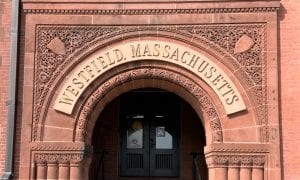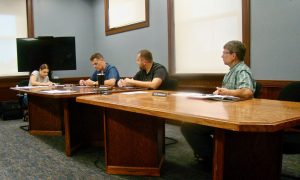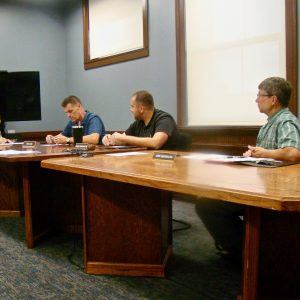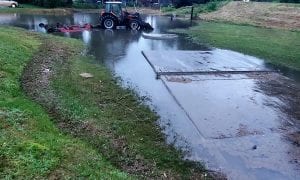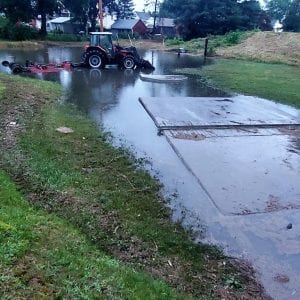WESTFIELD – The Water Commission heard details of the impact on city water rates of various ongoing and planned infrastructure projects which are adding significant long-term debt to the complex formula involved in setting water rates.
The base equation is that water rates have to generate sufficient revenue to meet the Water Resource expenses for the water division, which have historically has been kept lower by deferring major capital investment and debt.
That income and expenditure formula is also affected by the weather because city residents generally consume more water during dry years, especially summers, than during wet ones. Dry summers generate more water consumption for lawn irrigation and a higher level of outdoor activities and recreation.
Another factor in the rate debate is the rates themselves. High rates tend to promote a higher level of conservation, reducing water consumption and hence revenue.
Monday night Chris Bone of Tighe & Bond presented preliminary data to the Water Commission on the cost of capital investment on the department’s budget. Bone said that over the past 15 years the department has invested in a total of 14 projects, but that over the next five years it will initiate 14 projects with a price tag of roughly $15 million and will add about $1.5 million in debt to the department’s annual budget, for the next 20 years.
The department’s budget is currently about $5.5 million, but will balloon to over $7 million as the debt is added, meaning that revenue also has to increase, a process that depends on water rates and consumption.
The board members looked at the projects, which one commissioner divided the capital investments into “our projects” and “city projects” making a distinction between projects directly related to delivery of water to customers and involvements in city-sponsored improvement projects.
The water delivery projects include several of the most expensive improvements, such as repairing the Granville Reservoir dam damaged during Tropical Storm Irene ($2.1 million) and replacing the Granville pipeline ($2.8 million), both of which have been launched during the current fiscal year.
The department plans to begin replacing water meters during FY2014 ($3.35 million), replacing or refurbishing the East Mountain storage tank ($1 million) and making improvements to the city’s water treatment plant ($800,000) and the 2015 budget calls for the expenditure of $1.1 million for construction of a new municipal well and for land acquisition.
Spending linked to city-initiated projects includes the gaslight district initiative now underway ($1.5 million) and the recently completed Elm Street work ($700,000) to connect the improvements between the Great River Bridge and the Elm/Broad streets projects. Other work projected to begin during the current fiscal year includes $300,000 linked to the construction of the new elementary school at the corner of Ashley and Cross Streets, as well as $60,000 tied to the construction of a new Pochassic Road bridge on Drug Store Hill.
City street improvement projects for FY 2014 will include water line replacement for Western Avenue ($150,000) and Old Town improvements ($550,000) slated for FY 2016 for residential streets off Main Street.
Water Resource Superintendent Dave Billips said that the large number of projects reflects the fact that Water Commission have historically cut construction budgets to reduce the department’s expenditures and the need to increase rates to generate more revenue.
“We’re paying now for 30 to 40 years of neglect,” Billips said. “We should have had a $500,000 construction budget all that time but couldn’t because of limited revenue. Now we’re trying to rebuild the city’s (water) infrastructure.”
“It’s been the same endless cycle of chasing our tail,” Billips said. “We have to break that cycle” and increase revenue to fund annual construction budgets.
Commissioner Michael Burns Sr., said any increase has to be justified to ratepayers and members of the City Council.
“We can’t be spending money like drunken sailors,” Burns said, “but this presentation puts it into perspective for me. It’s an investment in the city.
“We’re going to have to show justification because some people don’t care about anything expect what’s in their water bill,” Burns said.
Commission Chairman Ronald Cole said the board has to deal with both public education and prepare for the impact of those projects.
“There’s not a lot of awareness in the (City) Council or in the community about what needs to be done,” Cole said. “We have to create awareness that these projects are not just ‘nice’ to do. They have to be done.”
Cole said that shutting down the Granville Reservoir for dam and pipeline improvements, which will be done concurrently, will have a financial impact on the department because surface water is the most cost-effective water supply, substantially least expensive than well water which will be the primary source during the dam and pipeline improvement projects.
“Shutting the reservoir means that revenue stays the same, but our operating costs go up,” C0ole said.
“We need to sit down with the mayor and City Council to discuss our revenue stream because nothing is changing for the next 20 years based on our bonding for these projects,” Cole said. “In the past we covered costs by not investing in infrastructure.”
Burns said that the commission should have been making small increases in the rates for the past several years to avoid the significant rate increase that will be needed to increase revenue to cover the department’s debt.
“Now it will be a big jump,” Burns said. “This (presentation) opened my eyes that this (rate increase process) won’t be gradual.”
The current rate for residents is $2.67 per 1,000 gallons of water, but could increase over the next five years to about $4 per 1,000 gallons, if not higher.
The board requested Bone to continue to refine the revenue and expense numbers working in conjunction with the department’s administration and present more definitive information to the board for its rate increase discussion.

